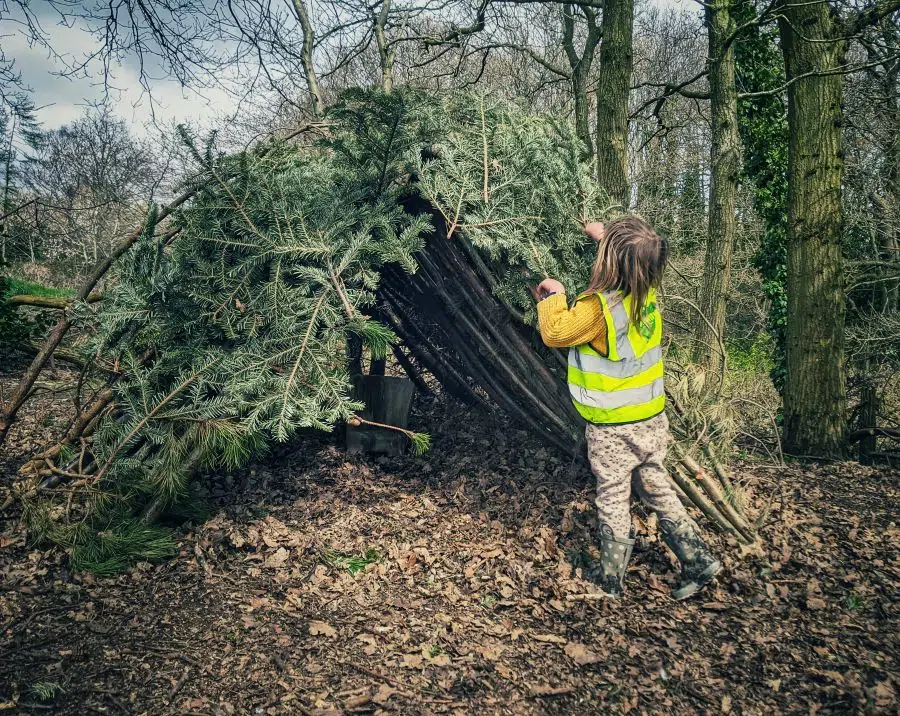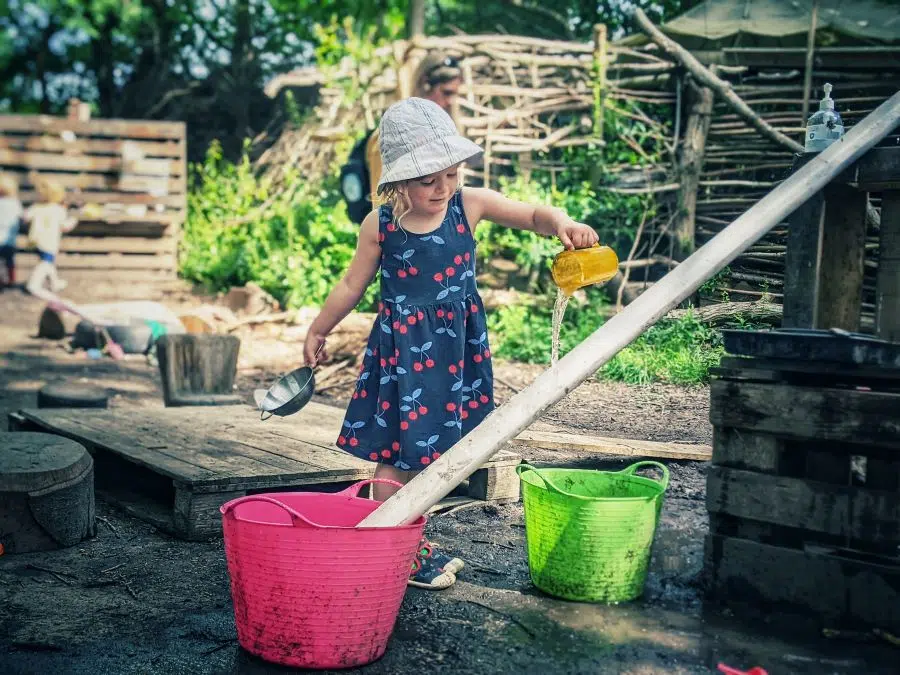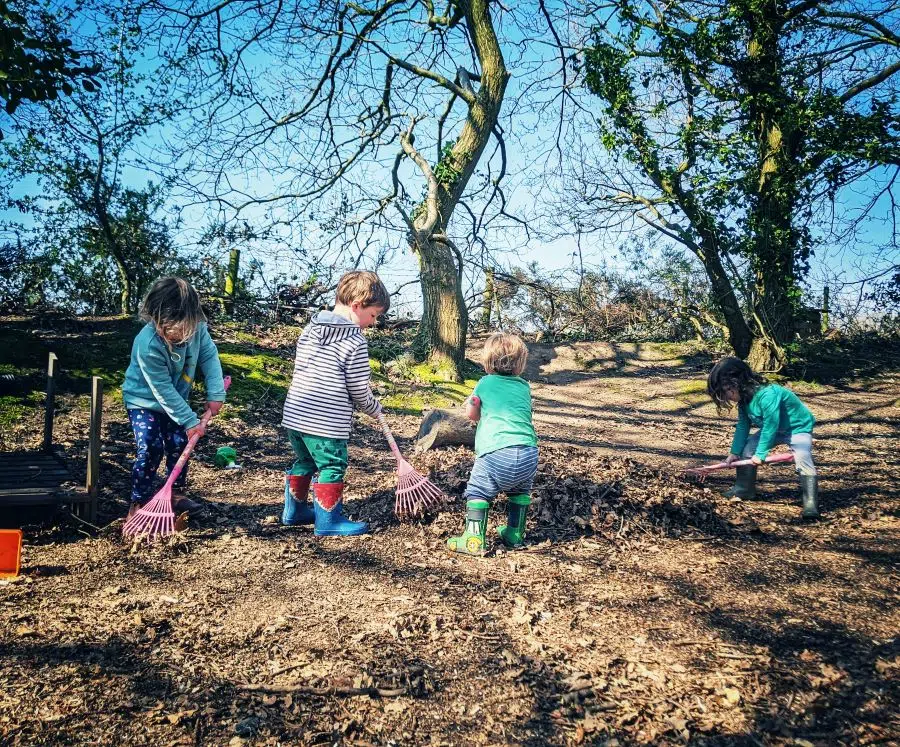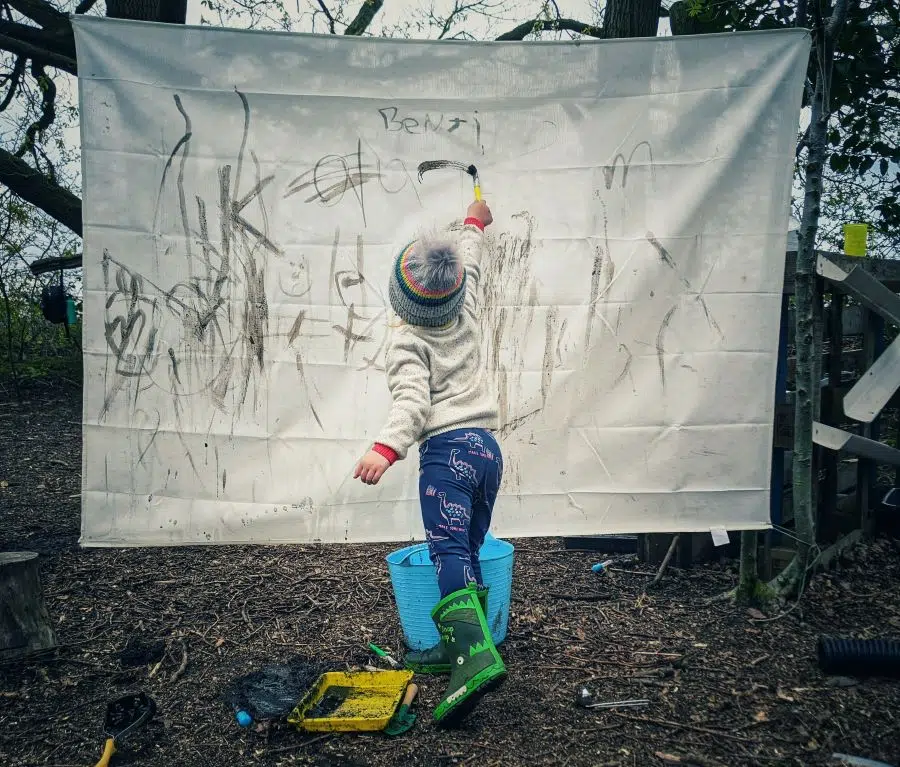If you haven’t yet tried a Forest school approach with your children, then you should know that the benefits are quite staggering. These are benefits that are backed up by both practice and research.
I’ve been involved in forest schools for the best part of twenty years. In that time, I would say that the most important 14 benefits of forest schools are:
- To inspire awe and wonder
- They encourage problem solving
- Extend vocabulary
- Prevent anxiety and depression
- An antidote to too much screen time
- Support cognitive function
- Being outdoors naturally relieves stress
- Resilience
- Opportunities for hands-on, real-life learning
- They allow practical skills to develop naturally
- Prevent childhood obesity
- Help to improve writing
- They support creativity
- Adults benefits just as much as children do
Let’s dive into all of these 14 benefits now, with lots of real-life examples and reseach to back everything up.

1. Inspring Awe And Wonder
There are certain things that you need to be outdoors to see and experience.
Think back for a moment to your own childhood memories and if you are like me, your first thoughts will draw you back to a time when you were outdoors. I can remember being outside at playtime far better than I can remember being in the classroom.
Just imagine:
A beautiful rainbow
A cobweb covered in droplets of rain
A beautiful Autumn leaf drifting down from the sky
A carpet of crunchy leaves underfoot to trample
The first-ever time you open a horse chestnut to reveal a shiny brown conker
A blackbird singing its morning song
A soft carpet of the first snow
These are true experiential learning experiences that will stay with our children much longer than any worksheet or picture in a book ever could.
Children need opportunities to experience awe and wonder. Those moments are what make us human and lead to inspiration and creative thinking.
2. Forest Schools Encourage Problem Solving
A forest school is alive with opportunities for natural problem-solving.
Ask the children to build a waterproof den, a home for a hedgehog, transport all the sticks across the site, or find as many brown and red objects as they can.
They could build a home for a fairy, or find out which birds live in their forest school – These are all problem-solving activities. Some of them can be continued in the classroom.
Think about the kind of activities your children are interested in? If you start with their interests they’ll be investigating in no time.

3. Extend Vocabulary
Believe it or not, many natural words such as buttercup and conker are being replaced in children’s dictionaries with new technology words such as chatroom and blog.
Some of our most respected children’s authors, like Michael Morpurgo have called this out recently, and we can also redress the balance by teaching our children the names of:
- trees
- plants
- flowers
- animals
- the names of animal homes
- the names of young animals
Passing this rich information to our children is important. A forest is alive with opportunities to learn new knowledge.
If we don’t teach our children about nature we can’t expect the next generation to have the skills and knowledge to protect it.
4. Prevent Anxiety And Depression
In the US in 2022, 37 million people are currently on anti-depressants. (Source)
In the UK last year, 70 million prescriptions were written for anti-depressants. (Some of those were repeat prescriptions but that’s still a staggering figure!)
Even before the pandemic, over a million children in the UK were diagnosed with mental illness.
It has long been known that one of the antidotes to depression is natural daylight. In fact, daylight actually stimulates the production of the hormone dopamine which soothes and calms us and acts as a natural anti-depressant.
Even better, those benefits extend to the adults too. Being in a forest environment naturally calms children. For many children, it is far less stressful than a school situation and was one of the reasons a Forest school approach was first developed.
With the current numbers of children at risk from mental illness after the last few years of lockdowns, using the outdoors more regularly should be our number one priority.
5. An Antidote To Too Much Screen Time
Did you know that every kind of technology device we use emits blue light?
That includes TV, laptops, tablets, and mobile phones.
Blue light can actually prevent our melatonin from working properly. Melatonin is the natural brain chemical we all need to wind down and feel sleepy, but too much technology can prevent this, leading to poor sleep patterns.
Technology can also be as addictive for our brain chemicals as smoking or alcohol. (Source)
Now, I’m not saying technology is all bad (I certainly used my fair share of it in lockdown), but it is important to recognize that our children need a balance. (Just try and take a mobile phone off a teenager and see the reaction you get).
Being outdoors in nature is the antidote.
Spending time in a forest site, surrounded by natural light produces the brain chemicals responsible for calming the brain and this helps us to sleep well, undoing the damage that too much blue light can cause.
Give children plenty of opportunities to climb, roll, push and pull, run and jump. Let them take safe risks so that their brains flood with natural endorphins. Once we know this, there really is no excuse to not spend at least part of our day outdoors. (Source)
6. Supporting Cognitive Function
Have you heard the term Biophilia before?
Biophilia means the innate human instinct to connect with nature. Watching birds flying overhead, watching a waterfall or a trickling, bubbling stream, lying down and looking up at the sky through the branches of an oak tree.
Tracing the pattern on a snail’s shell with your finger. These are all examples of Biophilia. When children connect with natural patterns in nature, their brains make changes that release positive chemicals.
In this more relaxed state children actually have increased cognitive function. In other words, spending time outdoors in nature can support and improve children’s ability to learn.
Sounds like magic doesn’t it?
Just give it a try and you will see the magic happen for yourself.
7. Being Outdoors Naturally Reduces Stress
When a child shouts, cries, or uses a loud voice indoors, the sound bounces off the walls, reverberates, and creates a stressful feeling.
But when children shout or yell outdoors, there are no walls to bounce off and so the sound is naturally set free and carried away.
For many children, the outdoors provides a much more relaxed environment. Green colors are also known to soothe and calm us, so a forest site is rich in natural calming properties.
Next time you are outdoors, just watch the children’s body language for a moment. Then compare it to their body language when they are sitting at desks.
A forest school environment also provides quiet spaces for reflection which are essential for some children at the moment.
But the benefits don’t just extend to the children. Adults can also benefit from spending more time in nature.

8. It Teaches Resilience
Even for those of us living in rainy climates, there is a crucial maxim about forest school weather:
There’s no such thing as bad weather, there are only the wrong clothes.
The key is to make sure you have a set of the right clothes (waterproofs) and wellies for all the children, but it’s also important to provide clothes so that the adults are warm and dry too.
That way, you’ll be ready for anything. Investing in good quality waterproofs for the adults as well as the children is important. A warm hat and gloves can help even the most reluctant adults to get outside.
Most children love to get wet, have fun splashing in puddles, collect rainwater and feel the wind on their faces. Try the link below for sets of children’s waterproofs.
Once you are dressed appropriately, the weather is no problem and a forest site is a brilliant place for building resilience in activities such as:
- Collecting and carrying wood and sticks
- Chopping and sawing sticks or whittling wood
- Building a waterproof den
- Building a dam
- Making a piece of beautiful transient art.
Children need to persevere at all these activities. Sometimes they will go wrong and they will need to try again. That means they will be building their resilience.
If you want more examples of Forest school activities visit:
9. It Provides Opportunities For Real-Life, Hands On Experiences
We all know that children learn best by doing or experiencing something firsthand. This is how new connections are hard-wired in the brain. There are lots of things you can’t teach from inside a classroom.
What does it feel like to climb an old tree?
What does it feel like to walk on grass with bare feet?
What does it feel like to roll down a slope, or eat marshmallows from a campfire?
These are learning experiences that children will remember and treasure.
Even better – If we give our children this kind of supported experience, their language will be richer, their vocabulary wider and their writing and creative work will become more interesting.
Outdoors the light is more vivid and our senses are heightened. Those are the kind of memories and experiences we want to create for our children to enjoy.
10. It Allows Practical Skills To Develop Naturally
A forest school environment is a great way to create a level playing field for all our children.
Very often, children who do not perform as well academically in the classroom, shine when they are outdoors and are allowed opportunities to problem solve, work in a more practical way or take the lead on a project.
Children learn in lots of different ways. We all prefer certain learning styles. For physical or more practical learners the forest is their natural classroom and it’s often surprising to see which children take the lead when you are outdoors.
Give children tasks like:
- Digging over beds
- Raking the soil
- Planting vegetables
- Weeding and Harvesting
- Measure a piece of land out using sticks and string
- Collect firewood for the campfire
11. Prevents Against Childhood Obesity
Even before the pandemic, childhood obesity was rising across Europe and many experts believe a rise in screen time is partly to blame.
In the United States, 13.4% of children between the ages of 2-5 are obese. (Source)
In the UK, the latest statistics show a staggering 9.9% of reception age children (age 4-5) are obese, with a further 13.1% overweight. In some parts of the UK, that’s even higher!
The answer is to give children as many opportunities to be as physically active as possible.
Research has proven that children’s rates of movement are naturally much higher in a Forest environment than in a classroom, and they are still learning just as much, if not more.
12. It Helps To Improve Writing
I’ve already mentioned the importance of building up a rich vocabulary by experiencing nature firsthand, but a forest school can actually help with the physical mechanics of writing as well.
Young children need to build up and develop 70 muscles in their arms before they find writing a comfortable experience.
If we force children into writing before these muscles have developed properly, they can find holding a pencil quite painful – no wonder then some children are reluctant writers!
It’s a sad fact that children are much less active at home than they were thirty years ago but we can help.
The answer is to provide lots of fine and gross movements and where better than in a forest school?
- waving branches
- twisting willow
- collecting sticks
- threading leaves
- climbing
These are just a few of the ways that we can allow those important muscles to build up. When children sit down to write, not only will they have more real-life experiences to write about, they will be more willing to take part in the writing process.
You won’t be able to stop them!!

13. It Encourages Creativity
When we are feeling relaxed and happy, (think of those positive brain chemicals that are produced by being in green spaces) we are more likely to tap into our creativity.
Luckily, there are endless opportunities in a forest school for creativity. Transient art is a lovely place to start as for many children it’s less threatening than having to produce a “finished” picture.
It means we can explore, investigate, problem-solve, move things around a bit, and tap into our true creative selves.
Start with a scavenger hunt to see what natural materials you can find.
With older children, you may want to create your own natural frames by binding sticks together with string, or you can just place sticks on the ground in a rectangle shape to create transient frames.
When the children have finished making their pictures, encourage them to return their materials to where they found them so we don’t have a negative impact on the environment. If you are worried about gathering evidence of the children’s creations, just take a photograph.
Imagination comes alive in a forest setting. The setting for Fairy Tales and stories like the Gruffalo suddenly become so much more real. It’s also important to allow children time to explore and play.
Give them plenty of child-led opportunities to play and explore in the forest site and you will start to hear their imaginations firing and their language developing at a rapid rate.
14. Adults Benefit As Much As The Children Do
Good news! Being in a forest or woodland is good for everyone. It’s not just the children that will reap those benefits. It’s also great for staff wellbeing and morale.
So what are you waiting for? Wrap up warm against the weather and get out there to enjoy all those natural benefits and positive effects.
It is important that Forest school sessions are not seen as a one-off event. Regular sessions will allow the children’s skills and confidence to develop over time.
Think of it as more of a process.
Ideally, the children will be visiting the site at least every fortnight for a session of at least two hours and for at least two seasons. This is to allow all the positive benefits mentioned above time to develop.
Occasionally, a child may become upset the first time they visit, if they haven’t been to a forest site before. The answer here is to persevere. Keep encouraging them to have fun and to explore the world around them.
Often the children who are most anxious in the first sessions are the ones who gain the most from a forest school experience over time. Seeing their confidence and resilience develop is great for them and great job satisfaction for us too.
Forest Schools – Some Top Tips For Success
The Forest school ethos originated in Scandinavia over 60 years ago, and is now well established across Europe, and is spreading in the United States, and other parts of the world.
It is only one branch of outdoor learning and there are specific training courses you can do if you want to become a recognised Forest school practitioner or Forest school leader.
But if you can’t access Forest school training at the moment there’s no need to worry. There are still lots of ways to reap the benefits of being outdoors in the fresh air and learning about nature, so don’t dismiss it.
We can all improve children’s learning by using the outdoors more regularly and it has never been more important than right now.
If you do have access to a Forest site near you, grab the opportunity with both hands, but even if you haven’t got a woodland area in your school or setting, it is the approach that is important, not necessarily the site. You can still gain lots of benefits by using a local park, a field or even a beach.
Make sure you risk assess the area first, but please be aware that natural risks are very much a part of this approach so you should approach the area looking for the risk benefits as well as the dangers.
- Always encourage the children not to pick any wild flowers or plants. Explain that some flowers are lovely to look at but shouldn’t be removed. There is plenty of guidance on the internet if you aren’t sure.
- Before you use the area with the children, take a walk around the area to check for any nasties such as glass, or dog and cat mess and use a thick pair of gloves to remove them.
- Check for any nettles, brambles or thistles. There is no need to remove them. Just explain to the children they should not go near them.
- Make sure you leave nothing behind when you leave (except footprints).
A forest school approach to learning is one with countless benefits. Think of the world we are living in at this moment and the climate changes that are happening.
There has never been a more urgent need to teach this generation of children to value and care for their natural environment before it’s too late.
Summing Up
There are countless benefits to a Forest school approach. Being in the fresh air, with nature all around us, using all our senses, particularly after the past two years of lockdowns is the tonic that we all need at the moment – children and adults alike.
And as an additional benefit, I’ve noticed that in forest school sessions, children quickly learn to regulate their behaviour.
Often, children who struggle to regulate themselves in a classroom situation are much more relaxed outdoors. It really is a no-brainer. Get outdoors. Enjoy!!
